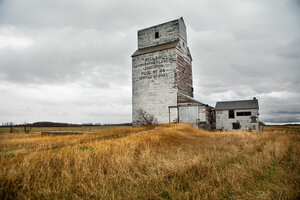In Pictures: On the hunt for Manitoba’s ‘prairie sentinels’

Beulah’s old grain elevator still stands tall on the prairie. Each town and village had its own elevator. Farmers today store their grain in modern structures.
Melanie Stetson Freeman/Staff
Inglis, Manitoba
Melanie and I were on a quest. While on assignment in Manitoba, photographer and reporter set out to document the old-style wooden grain elevators that tower over this prairie landscape. It took Melanie poring over a map to pick them out. But at one time, farmers say, visitors could drive down the highway and see rows of them in their rearview mirror.
The storage facilities, where grain would be loaded onto the national railway, have a connection with the world wars that ravaged the European grain market in the early 20th century. Production shifted to the Canadian prairies, attracting immigrants – many of them Ukrainians – who settled in towns next to the tracks, each community centered around its grain elevator that would stand as a beacon from afar.
The number of elevators increased from less than 100 in 1892 to 5,500 at their peak in the 1940s, according to the Inglis Grain Elevators National Historic Site.
Why We Wrote This
Our reporting team found surprise and delight when an assignment in Manitoba turned into a scavenger hunt for treasures from Canada’s agricultural past.
Currently, only about 80 remain – with the majority having burned down or fallen into such disrepair they needed to be demolished. They’ve been replaced with modern facilities that point to the more industrial nature of agriculture today.
In Inglis, a row of five wooden elevators has been preserved at the end of an abandoned rail line. A plaque at the site describes them poetically as “prairie sentinels” that act as “the silent guardians of Western Canadian agricultural history.”
But for us the real joy came from the elevators we stumbled upon – sighting an abandoned structure, tilting, with its paint chipped and letters missing from the name of the town it once served.
Some people might see the dilapidated elevators – with their shattered windows and rotting wood – as a blight on the landscape. Instead, we marveled at what they represent: the passing of 100 years, testimony to a slower, and some would argue simpler, way of life.

